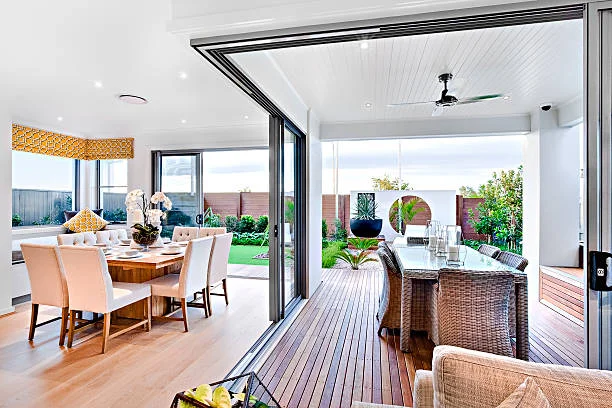Creating an extraordinary outdoor entertaining space transforms your backyard from a simple green area into a vibrant extension of your home. Imagine stepping into a beautifully designed outdoor room that seamlessly blends functionality, style, and comfort – a space where memories are made, gatherings happen, and your personal aesthetic comes to life through carefully chosen materials and thoughtful design.
Featured Post: Redefine outdoor entertaining with expert design tips and fresh ideas!
How to Plan Your Outdoor Entertaining Zones
Successful outdoor spaces begin with strategic zoning that maximizes every square foot of your backyard. Professional landscape designers recommend dividing your outdoor area into distinct functional zones that serve specific purposes. Consider creating three primary areas: a dining zone with a spacious paver patio, a lounging area with comfortable seating, and a cooking space that facilitates easy food preparation and social interaction. Each zone should feel intentional and connected, allowing smooth transitions between spaces.
When planning these zones, measure your available space carefully and sketch a rough layout. Consider traffic patterns, sunlight exposure, and existing landscape features. A well-designed outdoor entertaining area should feel intuitive and inviting, encouraging natural movement and interaction. Think about how you typically entertain; do you host large gatherings or intimate dinner parties? Your zone design should reflect your lifestyle and social preferences.
Connecting Each Zone Seamlessly with Paver Patios
Paver patios serve as the architectural backbone of outdoor entertaining spaces, creating visual continuity and functional pathways. Strategic patio design ensures smooth transitions between different areas, making your backyard feel like a cohesive, integrated environment. Consider using consistent paver materials and complementary colors to create a sense of unity throughout the space.
Walkways play a crucial role in connecting various zones, guiding guests naturally through your outdoor room. Curved pathways can add visual interest and soften geometric layouts, while straight paths provide clean, modern transitions. Width is another critical consideration – pathways should be at least 36 inches wide to accommodate comfortable walking and potential furniture placement. Integrate subtle landscape lighting along these paths to enhance safety and create a magical evening atmosphere.
Choosing the Right Paver Materials
Selecting the perfect paver material involves balancing aesthetic preferences with practical considerations. Concrete pavers offer versatility and affordability, with multiple color and texture options. They’re durable, resistant to cracking, and relatively low-maintenance. Brick pavers provide a classic, timeless look with rich historical charm, often featuring warm earthy tones that complement traditional architectural styles.
Natural stone pavers, such as granite, slate, or limestone, represent the premium option for discerning homeowners. These materials offer unparalleled beauty and unique character, with each stone displaying subtle variations in color and texture. While more expensive, natural stone pavers can significantly increase property value and create a luxurious outdoor environment. Consider your local climate, budget, and long-term maintenance capabilities when making your selection.
Personalizing Your Patio Installation
Paver selection goes beyond material – color, texture, and pattern play pivotal roles in creating visual interest. Neutral tones like soft grays and beiges provide a timeless backdrop, while bolder colors can make dramatic statements. Mixing different paver sizes and laying them in unique patterns like herringbone or basket weave can add sophisticated visual complexity to your outdoor space.
Texture introduces another layer of design sophistication. Smooth, uniform pavers create a sleek, modern aesthetic, while rougher, more irregular surfaces evoke rustic or natural environments. Consider how different textures interact with surrounding landscape elements and architectural features. Some homeowners enjoy creating visual “area rugs” using contrasting paver textures within larger patio spaces, defining specific zones through subtle design techniques.
The Role of a Professional Patio Builder in Bringing Your Design to Life
Professional paver contractors bring critical expertise to outdoor space design, ensuring proper installation, drainage, and long-term durability. Experienced professionals understand complex grading requirements, soil preparation, and drainage strategies that prevent future structural issues. They can recommend materials best suited to your local climate and provide precise installation techniques that maximize paver longevity.
A skilled contractor will also help you navigate potential challenges like uneven terrain, existing landscape features, or complex architectural considerations. They can create detailed 3D renderings, helping you visualize the final result before construction begins. While DIY installations might seem cost-effective, professional expertise prevents expensive mistakes and ensures a polished, professional outcome that adds genuine value to your property.
Add Warmth and Ambience with Smart Outdoor Lighting
Outdoor lighting transforms your entertaining space from daytime functional to nighttime magical. Layered lighting approaches combine different fixture types to create depth and atmosphere. String lights provide soft, romantic illumination, while strategically placed LED path lights enhance safety and visual interest. In-paver lighting can create stunning visual effects, subtly highlighting walkways and architectural features.
For homeowners seeking to truly elevate their outdoor ambiance and ensure lasting quality, professional installation is paramount. Expert providers specialize in designing and implementing comprehensive low-voltage outdoor lighting systems that not only enhance aesthetics but also improve safety and usability after dark. These custom solutions often utilize energy-efficient LED fixtures, strategically placed to illuminate pathways, steps, and key landscape elements like trees and patios. Investing in professional low-voltage outdoor lighting installation ensures a cohesive design that transforms your property into a captivating and secure evening retreat.
Consider incorporating smart lighting systems that allow color changes, dimming, and programmed scenes. Motion-activated security lighting can provide additional functionality, deterring potential intruders while illuminating key areas. Solar-powered options offer energy efficiency and easy installation, reducing long-term electrical costs. Experiment with different lighting temperatures – warm amber tones create intimate environments, while cooler whites provide crisp, modern aesthetics.
Incorporating Outdoor Kitchens and Fire Features
Outdoor kitchens and fire features elevate entertaining potential, creating immersive experiences that encourage social interaction. Built-in grills with prep areas allow hosts to cook while engaging with guests, breaking down traditional indoor/outdoor barriers. Pizza ovens provide unique culinary opportunities, transforming ordinary gatherings into memorable events.
Fire pits and outdoor fireplaces serve multiple purposes – providing warmth, creating focal points, and establishing natural gathering zones. Choose designs that complement your paver selection and overall landscape aesthetic. Some homeowners integrate built-in seating around fire features, maximizing space efficiency and creating intimate conversation areas.
Finishing Touches
Select outdoor furniture that balances comfort, durability, and style. Look for weather-resistant materials like powder-coated aluminum, synthetic wicker, and marine-grade fabrics. Modular seating arrangements offer flexibility, allowing easy reconfiguration for different gathering sizes. Incorporate outdoor rugs, throw pillows, and accessories that reflect your personal design aesthetic.
Surrounding landscape elements should complement your paver patio design. Choose low-maintenance plants that provide visual interest without requiring constant care. Drought-resistant native plants, ornamental grasses, and strategic shrub placement can create natural borders and soften hardscape elements.
Final Thoughts
- Plan distinct functional zones in your outdoor space
- Choose paver materials that balance aesthetics and durability
- Integrate professional installation for long-lasting results
- Layer lighting for ambience and functionality
- Select weather-resistant, comfortable furniture
- Consider fire features and outdoor cooking elements
- Create smooth transitions between different areas
Discover expert tips to transform your backyard—explore more design ideas!






